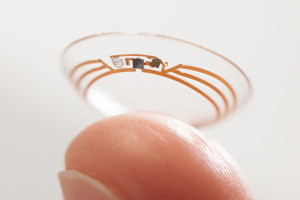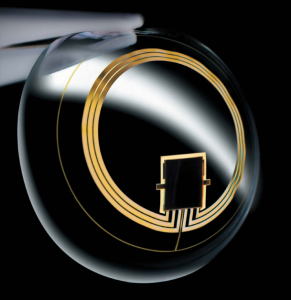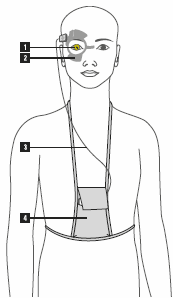Contact Lenses for more than Vision
As optometrists, we fit contact lenses daily. While new contact lens materials and designs have greatly increased the comfort and vision of our contact lens patients, we couldn’t help but wonder if contact lenses had additional diagnostic potential…
With that backdrop, some recent announcements and advancements in contact lens technology has got us very, very excited. Several different companies are now looking at ways of incorporating recent technological breakthroughs into contact lenses for the purposes of disease monitoring.
Today on Eye to the Future, we will delve into two contact lenses of the future.
Google/Alcon’s Blood Sugar Monitoring Lens
 The first, and one you might have heard about, is a recent paring between Google and Alcon (eye care branch of the drug company Novartis).
The first, and one you might have heard about, is a recent paring between Google and Alcon (eye care branch of the drug company Novartis).
While I personally cannot wait for a self driving car, the geniuses over a Google have equally excited our profession with their recent announcement to use their expertise to develop a contact lens that monitors blood sugar for diabetic patients.
This contact lens (pictured at left) would contain micro sensors to measure the blood sugar levels in the tears as well as a radio antenna thinner than a human hair. The data is then transmitted from the antenna to a smart phone app to allow the continuous monitoring of blood sugar.
With the epidemic of diabetes in this country, this non-invasive contact lens of the future could revolutionize the way patients monitor their blood glucose levels. In addition to the easy of measurements and lack of finger sticks, this information would be enormously helpful for primary care doctors and endocrinologists in developing specific treatments plans depending on how blood sugar levels change throughout the day.
The Triggerfish by Sensimed
 Everyone who’s been to the eye doctor knows the dreaded “Puff of Air” but what that test is actually measuring is the pressure inside your eye.
Everyone who’s been to the eye doctor knows the dreaded “Puff of Air” but what that test is actually measuring is the pressure inside your eye.
The Swiss company Sensimed has developed a wearable tech heavy contact lens called the Triggerfish. This contact lens of the future (right) was designed for the sole purpose of continuously measuring eye pressure over a 24 hour period.
Eye pressure, or intraocular pressure (IOP), is an important factor in the diagnosis of Glaucoma and even more important in determining the effectiveness of a Glaucoma treatment. The problem with eye pressure is that it fluctuates quite a bit throughout the day, as much as 50% or more in glaucoma patients.
IOP tends to be lowest in the afternoon or early evening when many people get eye exams. This can give us a false sense of security that the eye pressure is “normal”. Even worse, the IOP also tends to be highest when we can’t record it, usually the very early morning hours when most of us are just waking up or enjoying our morning cup of coffee.
Having a graph of the high and low points with this non-invasive testing would allow eye doctors the ability to choose specific treatments that are most effective when the eye pressure tends to be highest.
 The Triggerfish is worn in one eye (1). A wireless antenna (2) is positioned around the eye to collect the data from the contact lens. Then a set of wires (3) sends data from the antenna to a recording device worn by the patient (4).
The Triggerfish is worn in one eye (1). A wireless antenna (2) is positioned around the eye to collect the data from the contact lens. Then a set of wires (3) sends data from the antenna to a recording device worn by the patient (4).
The patient is fit with the contact lens and antenna in office and simply wears this device as well as a monitoring pack for 24 hours before returning to the doctor where the data is downloaded and analyzed. This is very similar to heart monitors often used by primary care doctors and cardiologists to record a patients cardiac measurements outside the office setting.
This lens is currently going through studies in the US to determine its safety and effectiveness, but is already in full use overseas.
For additional information on the Triggerfish diagnostic contact lens, please visit the Sensimed website.
We hope you have enjoyed this little overview of the some contact lenses of the future. If you have any questions, as always, please contact us and ask.


